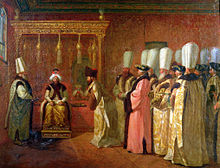Osman III
Throughout his reign, the alterations he implemented in high-level governmental positions, particularly that of the Grand Vizier, can be seen as efforts to diminish the overwhelming influence of the charitable authority[vague] prevalent during the previous sultan's era.
Contemporary historians stopped writing on political events due to the severe and freezing cold of January 1755.
[6] Osman was responsible for a firman in 1757 that preserved the Status Quo of various sites for Christians, Muslims, and Jews in the Holy Land.
[7] In the second year of his reign, Osman lost his mother Şehsuvar Sultan, afterward, the oldest prince Mehmed, died of illness on 22 December 1756.
It was attended by 5,000 people and contemporary sources mentioned that the prince was poisoned and killed on the initiative of Köse Mustafa Pasha.
Measures were taken against the tribes of Bozulus and Cihanbeyli, the Armenians (due to the turmoil in Iran), the bandits around Erzurum and Sivas, and the famous leader Karaosmanoğlu Hacı Mustafa Ağa.
[9] Osman III had four known consorts but no children, as did his elder half-brother Mahmud I. Sakaoğlu, a Turkish historian, speculates that the two may have suffered castration while imprisoned in the Kafes, but other historians point out that Osman III was 55 at the time of his rise and, unlike his brother, who had a long reign, he was on the throne for only three years before he died, and that both of these factors may have influenced the fact of not having children.
